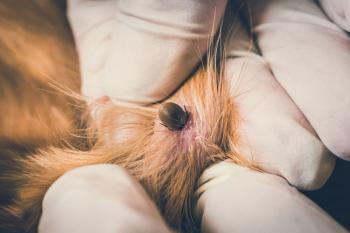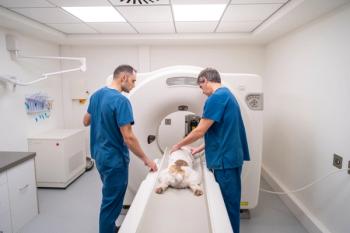
Snake bite: Pit vipers, part 2 (Proceedings)
Although many first-aid measures have been advocated for pit viper bite victims, none has been shown to prevent morbidity or mortality.
Although many first-aid measures have been advocated for pit viper bite victims, none has been shown to prevent morbidity or mortality6 Long-term follow-up of pit viper envenomated human patients has revealed that the majority of individuals with permanent loss of motion of the affected area or other negative sequelae had received some form of traditional first aid (e.g., cut and suck, constriction bands, and so on).7 The primary rule of first aid is to do no additional harm.
First-aid measures to be avoided include ice, incision and suction, tourniquets (which constriction bands quickly become with progressive limb swelling), and hot packs. Electroshock has been definitively shown to be ineffective in the treatment of pit viper envenomations and should not be attempted.8,9 Current recommendations for first aid in the field are to keep the victim calm, keep the bite site below heart level if possible, and transport the victim to a veterinary medical facility for primary medical intervention. Although two early abstracts reported that suction devices, capable of asserting two atmospheres of pressure, when applied over the bite wounds within 3 minutes after the bite and left in place for 30 minutes, may remove up to 30% of the injected venom volume subsequent research has indicated these devices are ineffective.
The patient should be hospitalized and monitored closely for a minimum of 8 hours for the onset of signs of envenomation. A severity score sheet should be recorded upon entry and at 6 hours post hospitalization at a minimum for every suspected snakebite victim. This advice cannot be overemphasized because the onset of clinical signs may be significantly delayed. The effects of snake venom are time dependent, any delay in initiating medical treatment is deleterious to the patient and may result in complications that cannot be corrected.
The initial medical response to a snake-bitten patient is to collect the appropriate pretreatment laboratory samples and make circumferential measurements at, above, and below the bite site to allow quantitative monitoring of the progression of swelling. An intravenous catheter should be placed and a crystalloid fluid drip started.
The patient can be pretreated with diphenhydramine given IV or subcutaneously (SQ) (small dogs and cats: 10 mg; large dog: 25–50 mg). Antihistamines have no effect on the venom or the course of the envenomation itself; however, they can calm the fractious patient to facilitate intravenous catheterization. Earlier beliefs that patients pretreated with antihistamines would be more refractory to allergic reactions have been put in doubt with specific clinical observations addressing this assertion.
The only proven specific therapy against pit viper envenomation is the administration of antivenin.10,11,12,13 Coagulation deficits, fluid loss, changes in neurologic status, cardiac conduction abnormalities, and the necrotizing effect of the venom can be dramatically reversed when antivenin treatment is initiated appropriately.
In North America polyvalent antivenin, which is effective against the venoms of all endemic pit viper species, is used. This polyvalent equine origin antivenin (Crotalidae) is made and marketed to the veterinary community by Fort Dodge Laboratories (Fort Dodge, IA). The antivenin is produced by inoculating horses with the venoms collected from Crotalus atrox (western diamondback rattlesnake), Crotalus adamenteus (eastern diamondback rattlesnake), Crotalus terrificus (South American rattlesnake), and Brothrops atrox (fer-de-lance). Once a horse attains a certain titer, serum is harvested and processed to concentrate the antivenom immunoglobulins. The processes used to extract these proteins result in a final product that, though rich in antibodies, has a very high equine protein contaminants and albumin component, often in the range of 50%.
A new antivenom (Crotalidae polyvalent immune Fab Ovine, Protherics Inc, Brentwood, TN) was approved for the human use by the U.S. Food and Drug Administration in late 2000. The new antivenom is a purified and lyophilized preparation of ovine Fab immunoglobin fragments. The ovine IgG molecules are cleaved to discard the inflammatory stimulating Fc portion of the antibody, retaining only the Fab molecules. The product is affinity purified and contains negligible amounts of extraneous proteins such as albumin. Advantages of this product include a high affinity for venom antigens, improved penetration into tissues (due to the smaller size of Fab compared to whole IgG), and decreased antigenic potential, thereby decreasing the risk of possible allergic reactions. A disadvantage may be the potential need for repeated administration because the smaller Fab molecules may be more rapidly cleared from the body.
Crotalidae polyvalent immune Fab (ovine) antivenom is prepared from the blood of healthy sheep immunized in groups with one of the following North American crotalid venoms: Crotalus atrox (western diamondback rattlesnake), C. adamanteus (eastern diamondback rattlesnake), C. scutulatus scutulatus (Mojave rattlesnake), and Agkistrodon piscivorus (cottonmouth or water moccasin). A monospecific antivenom is produced from each sheep group, and these four monospecific antivenoms are then mixed to prepare the final polyvalent antivenom. In theory, the immune response by each sheep to a single venom creates a monospecific antibody with a wider band of activity against the venom than would be gained by mounting a response to several venoms at once. In addition, the four immunizing snakes are all North American species and have been selected to provide the widest immune response to the venoms of pit vipers indigenous to the continent.
Skin testing for allergic reactions to the horse serum is difficult to evaluate in veterinary patients, and a test dose is not provided in the Fort Dodge packaging as it was in the Wyeth human product. Human victims of snake bites were often subjected to cutaneous hypersensitivity testing before equine origin antivenin was administered. In one study none of 12 early (anaphylactic) reactions were predicted by this test.14 Generally, slow administration of the antivenin initially will identify those patients who may have an allergic reaction.
Antivenin should be reconstituted with the provided diluent; saline may be added to completely fill the vial, ensuring that the antivenin is totally submerged to speed reconstitution. It should not be shaken but can be swirled to facilitate reconstitution. This usually takes between 10 and 15 minutes. Warming the vial to body temperature aids in dissolution into the liquid state. A second rinsing of the vial increases the amount of protein recovered considerably. Shaking or overheating can destroy the proteins and causes foaming, which makes it difficult to collect the antivenin into a syringe.
Antivenin should be diluted at a ratio of 1 vial to 100 to 250 mL of crystalloid fluids. In smaller patients the clinician should adjust the fluid infusion volume to prevent fluid overload of the patient. In one report, antivenin labeled with radioactive iodine (131 I) was given intravenously, and 85% accumulated at the site of envenomation within 2 hours.15
Administration should begin slowly as an intravenous infusion. If there is no evidence of an allergic reaction (e.g., nausea, hyperemia of inner pinna, fluffing of tail, pruritus), the rate of infusion can be increased. The entire initial dosage should be given within a half hour. The patient then should be reevaluated for further progression of the envenomation syndrome using the appropriate clinical and laboratory parameters.
The dosage of antivenin needed is calculated relative to the amount of venom injected, the body mass of the victim, and the bite site. Bites to the torso, tongue, or intravascular are severe envenomations that require prompt, aggressive antivenin administration. Smaller patients require higher doses of antivenin because the dose of venom per kilogram body weight of the victim is higher. Multiple vials may be necessary to treat severe envenomations adequately. The average dosage in dogs and cats is one to two vials of antivenin.
The earlier antivenin is administered, the more effective it is. The package insert advises using it within the first 4 hours. However, the product is effective as long as active venom components are found in the bloodstream. Tissue necrosis will not be reversed once it has occurred, but additional damage may be prevented. Antivenin is extremely effective in reversing venom-induced coagulation defects. Coagulation defects can be abated several days after envenomation. If clotting defects continue to be manifest, additional antivenin should be administered. Disseminated intravascular coagulation like syndromes should be treated with additional antivenin. Rattlesnake venom thrombin-like enzymes are not inhibited by heparin, and it should not be administered. Clotting anomalies secondary to envenomations are extremely difficult to reverse with blood products and transfusions.
Antivenin is extremely effective in reversing most rattlesnake venom induced thrombocytopenias. However, in timber rattlesnake (C. horridus) bites a platelet aggregating protein induces thrombocytopenia which is resistant to antivenin administration even though PT and PTT are restored.16
Patients exhibiting allergic reactions to antivenin can still receive it if needed in severe envenomations. It can be given as a slow intravenous drip and piggybacked with diphenhydramine and possibly epinephrine. Data in both human envenomation and veterinary envenomation databases has not identified a significantly higher reaction rate in patients who have received antivenin previously.7 Some veterinary patients have received antivenin yearly for several consecutive years.
Allergic reactions, though rare, are possible when administering antivenin. These can become manifest in one of three ways—by true anaphylaxis, an anaphylactoid reaction, and delayed serum sickness. The most common reaction to antivenin is an anaphylactoid reaction. This is a complement-mediated reaction to the rapid administration of a foreign protein, such as those seen in rapidly administered blood transfusions. Anaphylactoid reactions can usually be treated by stopping the antivenin infusion, administering diphenhydramine intravenously (small dogs and cats: 10 mg; large dogs: 25–50 mg), waiting 5 minutes, and then restarting the infusion of antivenin at a slower rate. Anaphylaxis is treated by stopping the infusion of antivenin and administering epinephrine, corticosteroids, and crystalloid fluid infusion. Patients taking beta-blockers must be monitored very closely. Beta-blockers may mask the early onset of anaphylaxis, which becomes more difficult to reverse as the reaction progresses. Delayed serum sickness is rare in dogs and cats. Onset of delayed serum sickness usually occurs 7 to 14 days after antivenin administration. If it does occur, treatment consists of antihistamines, often type 1 and type 2 inhibitors, and/or corticosteroids.
If the patient is in severe hypovolemic shock, hemoglobin glutamer-200 (bovine) (Oxyglobin, Biopure) may be administered as a colloid volume replacer and to increase oxygen delivery to damaged tissues. Oxyglobin has an advantage over other colloids in that it does not run the risk of inducing additional clotting abnormalities in the patient. There is debate about the use of colloidal fluids in pit viper envenomated patients because leakage of the colloid through damaged vascular walls may pull fluid out of the vascular space and into areas with rich capillary beds such as the pulmonary tissues.
Broad-spectrum antibiotics are recommended in veterinary patients after envenomation because of the number of pathogenic bacteria found in snakes' mouths and the amount of local tissue damage at the bite site. This is an area of controversy in the therapy of human snake bite victims.17,18
Pain is usually controlled with the antivenin. However, in patients in which no or limited amounts of antivenin are administered, pain control may require IV narcotics during the first 24 hours. Fentanyl is preferred and can be administered as a continuous rate infusion (loading dose 2 mg/kg then 0.5 mg/kg/hr). Morphine should be avoided due to its histamine-releasing activity, which may be confused with the onset of anaphylaxis. Nonsteroidal medications compound the risk of developing blood dyscrasias and clotting anomalies.
The use of corticosteroids in the treatment of pit viper envenomation is not generally recommended. Treatment of pit viper envenomations with corticosteroids has been repeatedly advocated, yet the rationale for their use is obscure and their ultimate therapeutic value is controversial. Numerous studies have examined the effects of treating venomous snake bites with corticosteroids. Most report a worsening of or no improvement in the patient's condition.19-31 Some studies have shown dramatic increases in mortality with the use of corticosteroids.32,33 The proposed detrimental effects of corticosteroids are inhibition of the victim's natural defenses against the venom, interference with the antivenin, and potentiation of the venom itself. Also, they potentially confound diagnostic testing, altering coagulation and other objective laboratory monitoring parameters useful in evaluating the clinical progression of the envenomation syndrome. In addition, human clinical trials have shown no beneficial effects of treatment of pit viper envenomation with corticosteroids.29 Corticosteroids are of little use in a hypotensive crisis and have little if any effect on the local tissue response to pit viper venom.
Fasciotomy is not indicated in the dog and cat. The rationale for this procedure is to combat damage from compartment syndromes, which are extremely rare in dogs and cats and are not common in humans.34 The risks associated with fasciotomy include surgery in the presence of significant coagulopathies, infection, and marked disfigurement after surgery with questionable outcomes.35,36 In patients that may develop a compartment syndrome secondary to pit viper envenomation, administration of additional antivenin has been demonstrated to lower the intramuscular pressure.37
Excision of the snake bite site is generally ineffective and can be complicated by coagulation defects secondary to the envenomation. Allen38 demonstrated that in cats and rabbits injected with crotalid venoms, excision of the bite area even 5 to 15 minutes after the injection of venom was "useless," and even when a large mass of skin and muscle around the injection site was removed, all the animals died.
Table 3. Pit Viper Envenomation Treatment Outline
1. Aggressive intravenous fluid therapy
2. Early intravenous antivenin administration
3. Monitoring of hemostasis and biochemical profiles
4. Antibiotic administration
5. No corticosteroids
References
19. Russell F: Snake venom poisoning in the United States: Experiences with 550 cases. JAMA 1975; 233(4): 341–344.
20. Van Mierop L: Snake bite symposium. J Fla Med Assoc 1976; 63: 101.
21. Arnold R: Treatment of snakebite. JAMA 1976; 236: 1843.
22. Arnold R: Controversies and hazards in the treatment of pit viper bites. South Med J 1979; 72: 902.
23. Glen J: Personal communication, Veterans Administration Medical Center, Venom Research Laboratories, Salt Lake City, June 1990.
24. Gennaro Jr J: Observations on treatment of snake bite in America. In Keegan H, MacFarlane W (eds): Venomous and Poisonous Animal and Noxious Plants of the Pacific Region. Tarrytown, Pergamon Press, 1963, p. 427.
25. Schottler W: Antihistamine, ACTH, cortisone and anesthetics in snakebite. Am J Trop Med 1954; 3: 1083.
26. Allam M: Comparison of cortisone and antivenin in the treatment of crotaline envenomation. In Buckley E, Porges N (eds): Venoms. Washington, American Association for Advancement of Science, 1956, p. 393.
27. Russell F, Emery J: Effects of corticosteroids on lethality of Agkistrodon contortrix venom. Am J Med Sci 1965; 241: 135.
28. Russell F: Effects of cortisone during immunization with Crotalus venom. A preliminary report. Toxicon 1965; 3: 65.
29. Reid H: Specific antivenin and prednisone in viper bite poisoning: A controlled trial. Br Med J 1963; 2: 1378.
30. Cunningham E: Snakebite—Role of corticosteroids as immediate therapy in an animal model. Am Surg 1979; 45: 757.
31. Wood J: Treatment of snake venom poisoning with ACTH and cortisone. Va Med Monthly 1955; 82: 130.
32. Reid H: Snake bite, Part 2. Treatment. Trop Doctor 1972; 2: 159.
33. Russell F: Shock following snakebite. JAMA 1966; 198: 171.
34. Mubarak S, Hargens A, Own C, et al: The wick catheter technique for measurement of intramuscular pressure: A new research and clinical tool. J Bone Joint Surg 1976; 58A: 1016.
35. Garfin S, Castilonia R, Mubarak S, et al: Rattlesnake bites and surgical decompression: Results using a laboratory model. Toxicon 1984; 22: 177–182.
36. Stewart R, Page C: Antivenin and fasciotomy/debridement in treatment of severe rattlesnake bite. Am J Surg 1989; 158: 543–547.
37. Garfin S, Castilonia R, Mubarak S, et al: The effect of antivenin on intramuscular pressure elevations induced by rattlesnake venom. Toxicon 1985; 23: 677–680.
38. Allen F: Mechanical treatment of venomous bites and wounds. South J Med 1938; 31: 1248.
Newsletter
From exam room tips to practice management insights, get trusted veterinary news delivered straight to your inbox—subscribe to dvm360.




